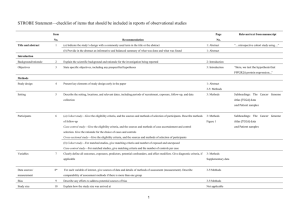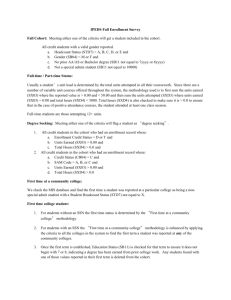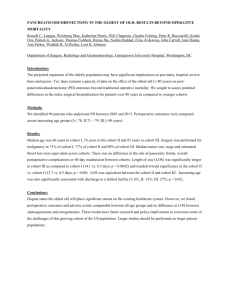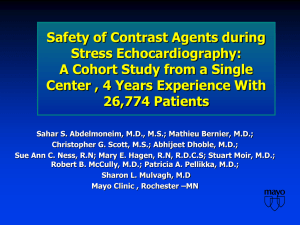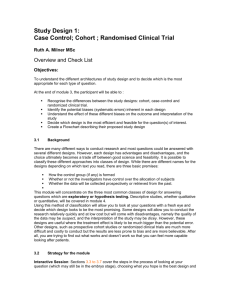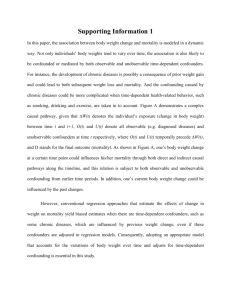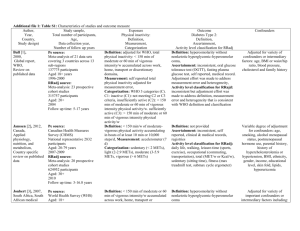file - BioMed Central
advertisement
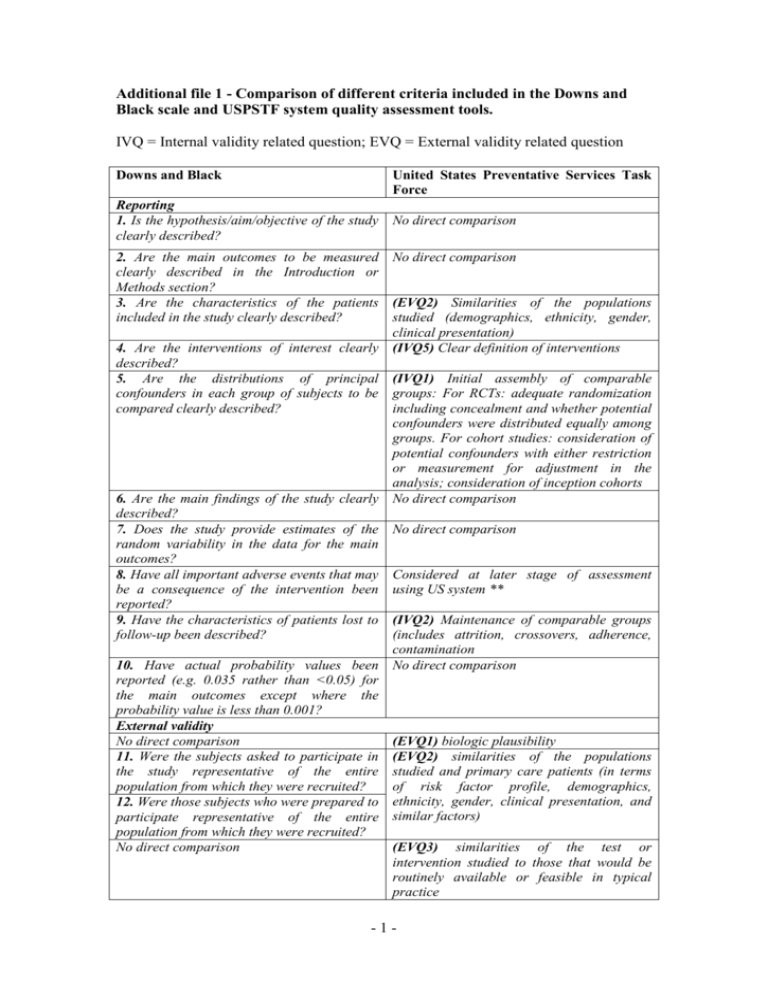
Additional file 1 - Comparison of different criteria included in the Downs and Black scale and USPSTF system quality assessment tools. IVQ = Internal validity related question; EVQ = External validity related question Downs and Black United States Preventative Services Task Force Reporting 1. Is the hypothesis/aim/objective of the study No direct comparison clearly described? 2. Are the main outcomes to be measured No direct comparison clearly described in the Introduction or Methods section? 3. Are the characteristics of the patients (EVQ2) Similarities of the populations included in the study clearly described? studied (demographics, ethnicity, gender, clinical presentation) 4. Are the interventions of interest clearly (IVQ5) Clear definition of interventions described? 5. Are the distributions of principal (IVQ1) Initial assembly of comparable confounders in each group of subjects to be groups: For RCTs: adequate randomization compared clearly described? including concealment and whether potential confounders were distributed equally among groups. For cohort studies: consideration of potential confounders with either restriction or measurement for adjustment in the analysis; consideration of inception cohorts 6. Are the main findings of the study clearly No direct comparison described? 7. Does the study provide estimates of the No direct comparison random variability in the data for the main outcomes? 8. Have all important adverse events that may Considered at later stage of assessment be a consequence of the intervention been using US system ** reported? 9. Have the characteristics of patients lost to (IVQ2) Maintenance of comparable groups follow-up been described? (includes attrition, crossovers, adherence, contamination 10. Have actual probability values been No direct comparison reported (e.g. 0.035 rather than <0.05) for the main outcomes except where the probability value is less than 0.001? External validity No direct comparison (EVQ1) biologic plausibility 11. Were the subjects asked to participate in (EVQ2) similarities of the populations the study representative of the entire studied and primary care patients (in terms population from which they were recruited? of risk factor profile, demographics, 12. Were those subjects who were prepared to ethnicity, gender, clinical presentation, and participate representative of the entire similar factors) population from which they were recruited? No direct comparison (EVQ3) similarities of the test or intervention studied to those that would be routinely available or feasible in typical practice -1- 13. Were the staff, places, and facilities where (EVQ4) clinical or social environmental the patients were treated, representative of circumstances in the studies that could the treatment the majority of patients receive? modify the results from those expected in a primary care setting Internal validity – bias 14. Was an attempt made to blind study subjects to the intervention they have received ? 15. Was an attempt made to blind those measuring the main outcomes of the intervention? 16. If any of the results of the study were based on “data dredging”, was this made clear? 17. In trials and cohort studies, do the analyses adjust for different lengths of followup of patients, or in case-control studies, is the time period between the intervention and outcome the same for cases and controls ? 18. Were the statistical tests used to assess the main outcomes appropriate? 19. Was compliance with the intervention/s reliable? (EVQ4) Measurements: equal, reliable, and valid (includes masking of outcome assessment) No direct comparison No direct comparison No direct comparison (IVQ2) Maintenance of comparable groups (includes attrition, crossovers, adherence, contamination) 20. Were the main outcome measures used (IVQ4) Measurements: equal, reliable, and accurate (valid and reliable)? valid (includes masking of outcome assessment) (IVQ6) All important outcomes considered 21. Were the patients in different intervention No direct comparison groups (trials and cohort studies) or were the cases and controls (case-control studies) recruited from the same population? Internal validity - confounding (selection bias) 22. Were study subjects in different No direct comparison intervention groups (trials and cohort studies) or were the cases and controls (casecontrol studies) recruited over the same period of time? 23. Were study subjects randomised to (IVQ1) Initial assembly of comparable intervention groups? groups: For RCTs: adequate randomization including concealment and whether potential confounders were distributed equally among groups. For cohort studies: consideration of potential confounders with either restriction or measurement for adjustment in the analysis; consideration of inception cohorts 24. Was the randomised intervention (IVQ1) Initial assembly of comparable assignment concealed from both patients and groups: For RCTs: adequate randomization health care staff until recruitment was including concealment and whether potential complete and irrevocable? confounders were distributed equally among groups. For cohort studies: consideration of potential confounders with either restriction -2- or measurement for adjustment in the analysis; consideration of inception cohorts. (IVQ4) Measurements: equal, reliable, and valid (includes masking of outcome assessment) 25. Was there adequate adjustment for (IVQ7) Analysis: adjustment for potential confounding in the analyses from which the confounders for cohort studies, or intentionmain findings were drawn? to-treat analysis for RCTs 26. Were losses of patients to follow-up taken (IVQ2) Maintenance of comparable groups into account? (includes attrition, crossovers, adherence, contamination) (IVQ3) Important differential loss to followup or overall high loss to follow-up Power 27. Did the study have sufficient power to No direct comparison detect a clinically important effect where the probability value for a difference being due to chance is less than 5%? ** The USPSTF system consists of a number of strata of which quality assessment is the first step. Adverse events are considered as part of a later stage where the reported and potential harms associated with the intervention in question are considered. -3-
